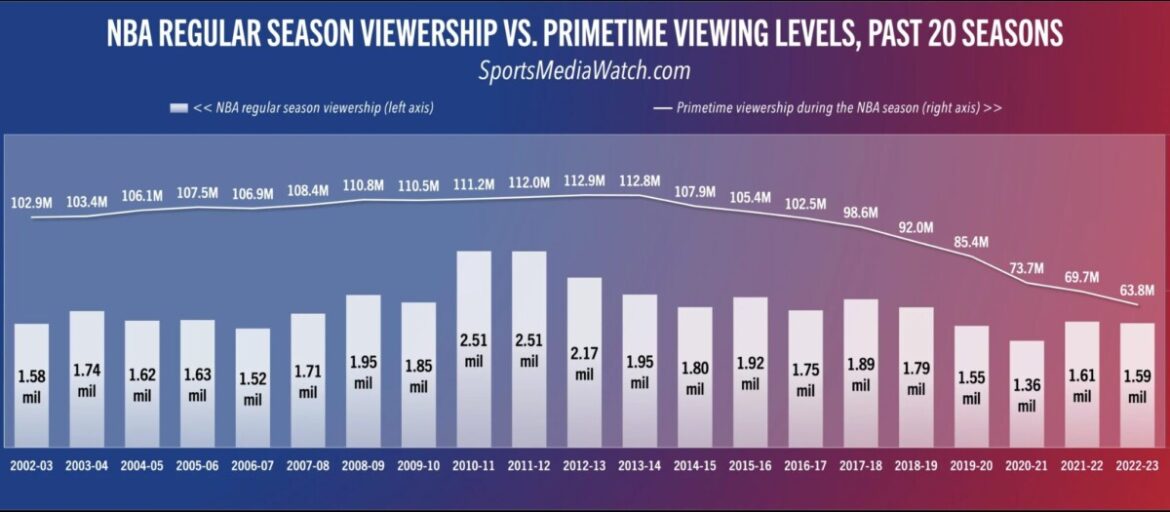Donovan West, Editor-in-Chief
@Dwest_courant
All the talk surrounding the NBA right now is the rapidly decreasing TV ratings. Viewership for NBA games across the major sports networks is down 25% (Sports Media Watch). The basketball world recently celebrated a five-year Christmas Day ratings high, averaging 5.25 million viewers per game, yet the NFL averaged 30 million on the same day. The past two NBA Finals have averaged around 12 million viewers per game, yet baseball’s championship, the World Series, averaged almost 16 million viewers in 2024. If people say the MLB is dying, the NBA has already been buried. Something has to change, and, with LeBron James and Stephen Curry soon exiting the league, that something has to come quickly- or else the NBA’s relevance will reach an all-time low. Here are three ways to help the faltering league.
1. Shorten the season by ten games (maybe more)
It is fairly obvious that 82 games is too many. Firstly, the toll such a long season takes on the players is undeniable. NBA athletes are getting injured at historic levels, which not only puts the players’ futures at risk but also lessens the product the NBA is putting out onto the court. Giannis Antetokounmpo, arguably the league’s best player, has played over 70 games just once in the past five years. Antetokounmpo is so busy dealing with injuries that him missing nearly 20% of the regular season has become a foregone conclusion.
Also, the constant injuries lead to the next problem with an 82-game season: load management. The term and action of “load management” has become so popular because of the high risk of injury combined with the low value of each individual game. Losing one game in an 82-game season doesn’t really matter, so it’s best for players not to risk injury and watch with the fans from the sidelines. Games between the Lakers and Warriors featuring Austin Reeves and Andrew Wiggins as the best players on the court is not a product that the casual viewer will be excited about. There’s a reason the NFL is so successful: their 18-week season means that practically every game is a must-win with high stakes, pushing players to participate no matter what and putting fans on their couches watching every week. A 72 or even 60-game season would solve some of these issues and help the NBA regain its mojo.
2. Reinvigorate division rivalries
Division rivalries characterized the old NBA. The constant battling, players and fans, between the Celtics, 76ers, and Knicks made each Atlantic Division game must-see TV. The Bulls and Pistons captivated the 1990s viewer with the pure hatred each one had for their division foe. The Spurs and Mavericks had several all-time inner-division matchups that skyrocketed television ratings.
Yet, now, that has all been lost. The regular season is just a race to the top of the standings, as teams seem to be battling against themselves more than against others. The NBA doesn’t have rivalries like the NFL’s Ravens-Steelers or the MLB’s Yankees-Red Sox that draw in viewership. The Knicks-76ers playoff series last year is the only recent example I can think of where the NBA world saw real hatred between players and fans. The result? It was one of the best playoff series of the last couple of years. That energy and passion need to be a constant on the NBA court.
So, how do we do it? First, have the Emirates NBA Cup group stage be played in-division. There is no doubt that the NBA Cup brings more juice than the average regular season game; adding division rivalries to this competitive basketball played on brightly colored courts would only make the in-season tournament better. Couple this with awarding an automatic playoff spot to the winner of each division, and rivalries would be back in the NBA. Not only would the NBA Cup group stage hold more meaning, but all division games would hold massive playoff implications, meaning stars would suit up. The NBA is an entertainment business, so reinvigorating rivalries and passion for the game is a must.
3. Move the three-point line back
The three-point revolution, once praised and glorified, might be the reason for the decline of the NBA’s ratings. Yes, in a dream world, 25-footers swishing through the net is one of the most exciting aspects of basketball. Yet, when all the viewer sees is these outrageously long shots being thrown up due to analytics, the game goes stale.
Look at the numbers: in 2005, teams were shooting under 16 threes per game; now, they are shooting almost 40. And this number should only rise, as the reigning champion Boston Celtics are shooting almost 50 threes a game. Not only does the repetitiveness of the shot chucking grow boring, but it is objectively a lower percentage shot. The league average two-point percentage is nearly 20 points higher than the three-point percentage. To a fan, the game is more interesting when more shots are being made. To a fan, the game is more enjoyable when there is variety in a team’s offense. To a fan, the game is less interesting when nearly half the shots are from Spike Lee’s lap.
So, the solution is to move the three-point line back. Based on the current league averages, the expected value of a three and a two-pointer is nearly the same (1.09 points). To disincentivize three-pointers and improve the NBA’s product, that has to change. Moving the three-point line back to 25 or 26 feet would lessen the three-point percentage and make teams rethink the data, resulting in less of the shot-chucking that has ruined the league.
Now, without any changes to court size or the shape of the three-point line, a retreat of the arc may necessitate eliminating the corner three – but that may be a good thing. According to a research study by 82games, the corner three is the most efficient and productive shot in all of basketball. The average corner three percentage is roughly 42.5, which results in a predicted 118.8 points per 100 possessions. That is the most expected points of any spot on the court – more than a layup. The corner three’s ease and efficiency have kickstarted another three-point boom and must be changed.
The first step? Moving the three-point line back.
The changes aren’t complicated; someone just has to be courageous enough to implement them.




